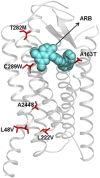International Union of Basic and Clinical Pharmacology. XCIX. Angiotensin Receptors: Interpreters of Pathophysiological Angiotensinergic Stimuli [corrected]
- PMID: 26315714
- PMCID: PMC4630565
- DOI: 10.1124/pr.114.010454
International Union of Basic and Clinical Pharmacology. XCIX. Angiotensin Receptors: Interpreters of Pathophysiological Angiotensinergic Stimuli [corrected]
Erratum in
-
Correction to "Angiotensin Receptors: Interpreters of Pathophysiological Angiotensinergic Stimuli".Pharmacol Rev. 2015 Oct;67(4):820. doi: 10.1124/pr.114.010454err. Pharmacol Rev. 2015. PMID: 26335847 Free PMC article. No abstract available.
Abstract
The renin angiotensin system (RAS) produced hormone peptides regulate many vital body functions. Dysfunctional signaling by receptors for RAS peptides leads to pathologic states. Nearly half of humanity today would likely benefit from modern drugs targeting these receptors. The receptors for RAS peptides consist of three G-protein-coupled receptors—the angiotensin II type 1 receptor (AT1 receptor), the angiotensin II type 2 receptor (AT2 receptor), the MAS receptor—and a type II trans-membrane zinc protein—the candidate angiotensin IV receptor (AngIV binding site). The prorenin receptor is a relatively new contender for consideration, but is not included here because the role of prorenin receptor as an independent endocrine mediator is presently unclear. The full spectrum of biologic characteristics of these receptors is still evolving, but there is evidence establishing unique roles of each receptor in cardiovascular, hemodynamic, neurologic, renal, and endothelial functions, as well as in cell proliferation, survival, matrix-cell interaction, and inflammation. Therapeutic agents targeted to these receptors are either in active use in clinical intervention of major common diseases or under evaluation for repurposing in many other disorders. Broad-spectrum influence these receptors produce in complex pathophysiological context in our body highlights their role as precise interpreters of distinctive angiotensinergic peptide cues. This review article summarizes findings published in the last 15 years on the structure, pharmacology, signaling, physiology, and disease states related to angiotensin receptors. We also discuss the challenges the pharmacologist presently faces in formally accepting newer members as established angiotensin receptors and emphasize necessary future developments.
Copyright © 2015 by The American Society for Pharmacology and Experimental Therapeutics.
Figures










Similar articles
-
A century old renin-angiotensin system still grows with endless possibilities: AT1 receptor signaling cascades in cardiovascular physiopathology.Cell Signal. 2014 Oct;26(10):2147-60. doi: 10.1016/j.cellsig.2014.06.011. Epub 2014 Jul 5. Cell Signal. 2014. PMID: 25007996 Review.
-
The vasoprotective axes of the renin-angiotensin system: Physiological relevance and therapeutic implications in cardiovascular, hypertensive and kidney diseases.Pharmacol Res. 2017 Nov;125(Pt A):21-38. doi: 10.1016/j.phrs.2017.06.005. Epub 2017 Jun 12. Pharmacol Res. 2017. PMID: 28619367 Free PMC article. Review.
-
Evolving views on the first two ligands of the angiotensin II type 2 receptor. From putative antagonists to potential agonists?Eur J Pharmacol. 2023 Dec 15;961:176189. doi: 10.1016/j.ejphar.2023.176189. Epub 2023 Nov 10. Eur J Pharmacol. 2023. PMID: 37951489 Review.
-
Mapping tissue angiotensin-converting enzyme and angiotensin AT1, AT2 and AT4 receptors.J Hypertens. 1998 Dec;16(12 Pt 2):2027-37. doi: 10.1097/00004872-199816121-00026. J Hypertens. 1998. PMID: 9886893 Review.
-
Unraveling the crosstalk between renin-angiotensin system receptors.Acta Physiol (Oxf). 2024 May;240(5):e14134. doi: 10.1111/apha.14134. Epub 2024 Mar 15. Acta Physiol (Oxf). 2024. PMID: 38488216 Review.
Cited by
-
Allisartan isoproxil reduces mortality of stroke-prone rats and protects against cerebrovascular, cardiac, and aortic damage.Acta Pharmacol Sin. 2021 Jun;42(6):871-884. doi: 10.1038/s41401-021-00684-7. Epub 2021 May 17. Acta Pharmacol Sin. 2021. PMID: 34002042 Free PMC article.
-
Angiotensin and Endothelin Receptor Structures With Implications for Signaling Regulation and Pharmacological Targeting.Front Endocrinol (Lausanne). 2022 Apr 19;13:880002. doi: 10.3389/fendo.2022.880002. eCollection 2022. Front Endocrinol (Lausanne). 2022. PMID: 35518926 Free PMC article. Review.
-
Roles of G Protein-Coupled Receptors (GPCRs) in Gastrointestinal Cancers: Focus on Sphingosine 1-Shosphate Receptors, Angiotensin II Receptors, and Estrogen-Related GPCRs.Cells. 2021 Nov 3;10(11):2988. doi: 10.3390/cells10112988. Cells. 2021. PMID: 34831211 Free PMC article. Review.
-
Single-Nucleotide Polymorphism in Genes Encoding G Protein Subunits GNB3 and GNAQ Increase the Risk of Cardiovascular Morbidity among Patients Undergoing Renal Replacement Therapy.Int J Mol Sci. 2023 Oct 17;24(20):15260. doi: 10.3390/ijms242015260. Int J Mol Sci. 2023. PMID: 37894940 Free PMC article.
-
Role of circulating molecules in age-related cardiovascular and metabolic disorders.Inflamm Regen. 2022 Jan 10;42(1):2. doi: 10.1186/s41232-021-00187-2. Inflamm Regen. 2022. PMID: 35012677 Free PMC article. Review.
References
-
- Abadir PM, Periasamy A, Carey RM, Siragy HM. (2006) Angiotensin II type 2 receptor-bradykinin B2 receptor functional heterodimerization. Hypertension 48:316–322. - PubMed
-
- Abbasi S, Su B, Kellems RE, Yang J, Xia Y. (2005) The essential role of MEKK3 signaling in angiotensin II-induced calcineurin/nuclear factor of activated T-cells activation. J Biol Chem 280:36737–36746. - PubMed
-
- AbdAlla S, Abdel-Baset A, Lother H, el Massiery A, Quitterer U. (2005) Mesangial AT1/B2 receptor heterodimers contribute to angiotensin II hyperresponsiveness in experimental hypertension. J Mol Neurosci 26:185–192. - PubMed
-
- AbdAlla S, Lother H, Abdel-tawab AM, Quitterer U. (2001a) The angiotensin II AT2 receptor is an AT1 receptor antagonist. J Biol Chem 276:39721–39726. - PubMed
-
- AbdAlla S, Lother H, el Massiery A, Quitterer U. (2001b) Increased AT(1) receptor heterodimers in preeclampsia mediate enhanced angiotensin II responsiveness. Nat Med 7:1003–1009. - PubMed
Publication types
MeSH terms
Substances
Grants and funding
LinkOut - more resources
Full Text Sources
Other Literature Sources
Molecular Biology Databases
Research Materials

